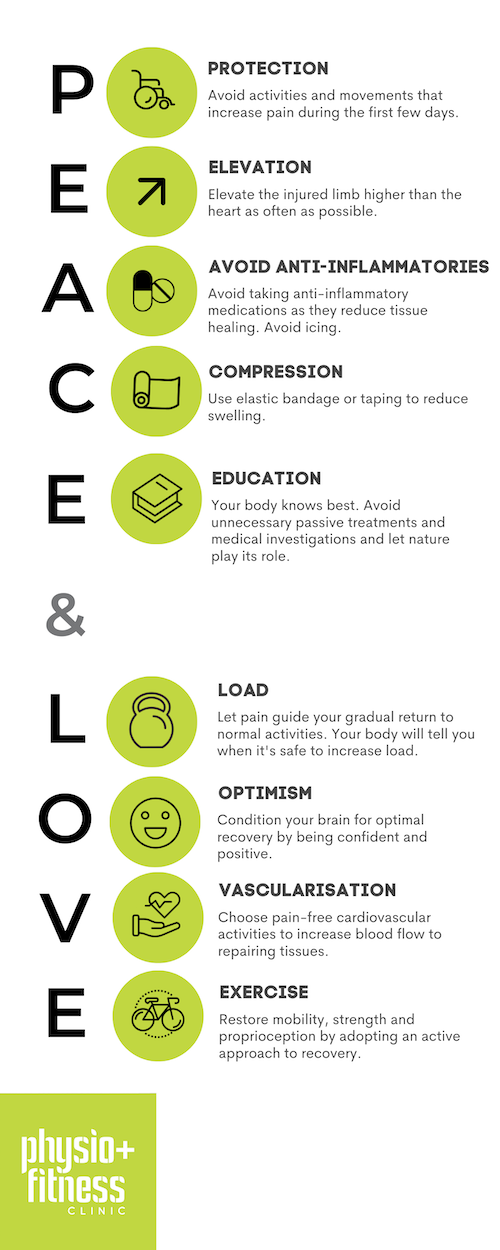Acute injury management: Forget RICER, its time for PEACE & LOVE
Oh no, you just rolled your ankle. Quickly, grab the ice! Or, based recent advances in science, maybe don’t…
For years we have been told to manage an acute injury with RICER – Rest, Ice, Compression, Elevation and (if appropriate) Referral. While at the time it was created this approach was well founded, years of research since on tissue healing have led experts to recommend otherwise. For example, traditional icing procedures (i.e. applying an ice pack to the injury region) may actually delay the start of the healing process, and lengthen recovery timelines.
So, what do the experts recommend instead? PEACE and LOVE.

Initial management is with PEACE:
Protect – In the 1 – 3 days following an injury, it is advised you reduce the amount of load placed on it. This will help reduced bleeding, reduce fibre displacement and minimise further irritation. Importantly, protect doesn’t mean stopping completely, as prolonged rest will compromise strength and tissue quality, complicating recovery. Rather, aim to minimise activity based on pain (aim for activity to only result in mild pain at worst).
Elevate – Aim to elevate the limb higher than the heart, to help control swelling, and promote flow of fluid away from the injury region.
Avoid Anti-inflammatories – The various forms of inflammation across the healing timeline are necessary for healing. For example, inflammation brings with it macrophages and other neutrophils, that assist in removing debris and waste resulting from the initial injury. Using anti-inflammatories will inhibit inflammation, possibly delaying healing processes and impacting long-term recovery.
Compression – Bandages or taping will help control swelling, and limit tissue bleeding.
Educate – This is one for the therapists/physio’s. Therapists should help educate patients on the importance of an active approach, avoiding passive modalities like electrotherapy or acupuncture which don’t benefit much in the initial stages of healing.
After the initial few days have passed, management shifts to LOVE:
Load –Movement/exercise should be added early, with the aim of resuming normal activity as soon as symptoms allow. This should be at an intensity that doesn’t exacerbate pain. Load acts to promote repair and remodelling of tissue, while building tissue tolerance.
Optimism – Beliefs and emotions can impact recovery. An optimistic expectation for recovery is associated with improved outcomes.
Vascularisation – Cardiovascular/aerobic activity should start a few days after the initial injury. This promotes blood flow to the injury region, and improves capacity for returning to regular activities earlier.
Exercise – Strong evidence supports the use of exercise in management of soft tissue injuries, as it helps restore strength and mobility after an injury. This should be at an intensity that doesn’t aggravate pain.
References:
Dubois, B., & Esculier, J. F. (2020). Soft-tissue injuries simply need PEACE and LOVE. British journal of sports medicine, 54(2), 72-73.
Wang, Z. R., & Ni, G. X. (2021). Is it time to put traditional cold therapy in rehabilitation of soft-tissue injuries out to pasture?. World Journal of Clinical Cases, 9(17), 4116.
